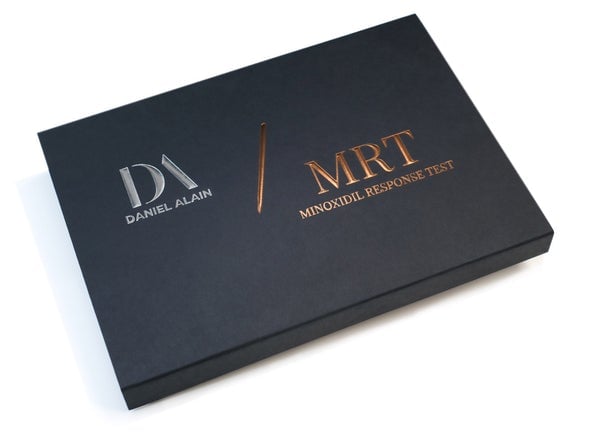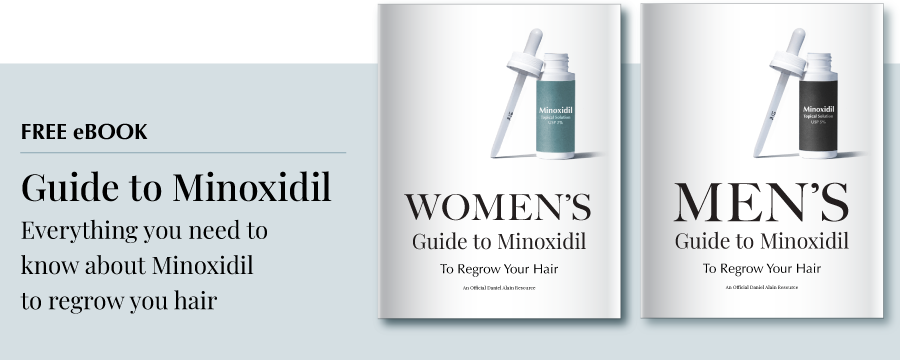Hair Shedding | Minoxidil | Hair Loss Testing | Hair Loss | Men's Minoxidil | Women's Minoxidil
Do You Have to Use Minoxidil Forever? | Daniel Alain

You’ve heard about Minoxidil, or maybe you use it to treat hair loss, and with daily applications, you’re wondering how long you have to commit to using Minoxidil. Applying the foam or liquid solution every day, and waiting hours for your hair to dry before styling, is painstaking. Which brings up an important question: Do you have to use Minoxidil forever? Or can you stop after you see results—if you see results?
In most hair loss cases, you do have to use Minoxidil forever to achieve and maintain hair growth. Otherwise, discontinuing could send your hair to the state it was in when you initially started treatment. In other words, hair loss would likely continue. However, there are some exceptions.
To avoid wasting time and money chasing a treatment that may not work, it’s essential to explore your options.
Daniel Alain can help you determine if Minoxidil is the right hair loss solution for you. But first, what causes hair loss, and how long will you have to use Minoxidil to see (and maintain) results?
HAIR LOSS CONDITIONS & THE AVERAGE MINOXIDIL TIMELINE
Minoxidil is an FDA-approved hair loss treatment sold by popular brand names like Rogaine®, Keeps, Hims, Hers, and Nioxin. Minoxidil may stimulate hair regrowth on the scalp for some men and women, but not all.
When it comes to hair loss, there are a plethora of causes—from over-styling and heat damage to dietary and biological reasons. Identifying the root cause can be tricky.
According to the American Hair Loss Association, over 40% of women are struggling with some form of hair loss. As many as 70% of men will experience hair loss as they age, with many noticing signs before they’re even 21. Medications like Minoxidil may effectively regrow hair in genetic hair loss conditions.
Do you have to use Minoxidil forever? While discontinuing Minoxidil may be an option for some, it isn’t for most. Below, we’ll outline the most common hair loss conditions and give you an idea of how long you’ll need to take Minoxidil for each one.
Telogen Effluvium
Are we what we eat? Not exactly. But nutrition impacts every part of the body, hair included. Certain foods stimulate hair growth, while other foods can trigger hair loss. Telogen effluvium is the sudden onset of diffuse hair loss associated with diet and stress. It usually presents with excessive shedding triggered by low iron, thyroid issues, or crash diets.
What can you do? Addressing the trigger is usually the first step in remedying hair loss. Once that’s been addressed, hair loss will slow down and eventually stop. An anti-hair shedding treatment for men and for women can also help to strengthen hair strands during vigorous activities like washing and styling, and give you shiny, gorgeous, volumized hair.
Excessive shedding is one of the first signs of the onset of genetic hair loss. If the hair loss is significant, Minoxidil could help to stimulate regrowth if it is determined the hair loss is due to genetics. Do you have to use Minoxidil forever in cases where hair loss is temporary? Usually, no. Once you isolate the trigger and make changes as needed, the shedding should minimize. It will only require long-term treatment for rarer cases of chronic telogen effluvium, where the entire scalp sheds excessively.
Anagen Effluvium
Anagen effluvium is sudden hair loss triggered by the impaired mitotic or metabolic activity of hair follicles. Huh? Essentially, this type of non-scarring alopecia is a common result of chemotherapy.
In other words, chemo attacks all the rapidly dividing cells in your body, yes, even the healthy ones. Hair follicles, some of the fastest-growing cells in your body, are targeted just as much as cancer cells. Sadly, this often results in anagen effluvium or chemo-induced alopecia.
Battling cancer is extremely difficult, and dealing with hair loss on top doesn’t make matters easier.
While there is no way to prevent cancer-related hair loss, remember that it is temporary. In most cases, hair will regrow once you finish chemo. So what can you do in the interim to maintain your self-confidence and continuity with your image?
You may benefit from a hair topper or human hair wig, which can offer coverage to conceal hair loss as your body responds to chemo.
Alopecia Areata
Did you know that stress can cause hair loss? Alopecia areata is just that: an autoimmune response to high stress. It can occur anywhere on the body but typically presents in circular patches of hair loss along the scalp. The immune system attacks hair follicles and causes hair loss. Anyone can develop alopecia areata, but your chances are higher if it has affected someone in your family.
As far as treatment, the solution is easier said than done: minimize the stress. This is no easy feat—especially with the state of the world as of late (pandemic, inflation, war… it’s enough to make all of us lose our hair). But there are ways to reduce stress.
Identify your triggers and find an outlet that helps you relieve your stress. Go on a long walk, have a long chat with a good friend, listen to the Calm app, pet your favorite furry friend. By alleviating your stress triggers, the hair growth cycle can resume, sending more hairs into the growth phase (anagen), and you’ll start to see new growth in about 3-6 months.
Corticosteroids (a class of steroid hormones) and Minoxidil are also effective in stopping the patches of hair loss from returning. Do you have to use Minoxidil forever with stress-related hair loss? If you can reduce your stress triggers, you can reduce Minoxidil treatments as your hair regrows.
Scarring Alopecia
Unlike other forms of hair loss we’ve discussed, scarring alopecia (cicatricial alopecia) is a rare inflammatory condition that destroys hair follicles and replaces them with scar tissue, making hair unable to regrow. Trauma such as scalp burns or severe infections can also cause scarring alopecia.
Unfortunately, there is no known cure for this type of hair loss.
While scarring alopecia is permanent and irreversible, you can take steps to reduce the amount of hair loss and severity of scarring. When combined with treatments like hair autografting (hair transplantation), Minoxidil has been shown to stimulate the growth of the remaining hair follicles.
Do you have to use Minoxidil forever if you have scarring alopecia? Most of the time, yes. Since the scar tissue is permanent, you’ll likely have to use Minoxidil long-term to maintain results.
Traction Alopecia
As the name suggests, traction (or mechanical) alopecia results from repeated trauma to the hair follicles. Unfortunately, many of today’s trending styles for women result in excessive tugging on the hair follicles.
For instance, pulling your hair into tight hairstyles like braids or buns that cause excess strain on the scalp. That ultra-chic, famous Ariana Grande ponytail is a prime example. Fabulous? Absolutely. Damaging? Potentially. Over time, you may experience symptoms like irritation, hair thinning, redness, or hair loss along the hairline.
You can prevent traction alopecia by making styling adjustments such as wearing looser hairstyles. However, repeated strain on the hair follicles can result in irreversible scarring alopecia. According to a 2019 study in the American Journal of Clinical Dermatology, Minoxidil can help to accelerate regrowth in early traction alopecia. Still, you should avoid it if the area is inflamed.
So do you have to use Minoxidil forever if you have traction alopecia? Not usually. Once you’re satisfied with the growth and the hair loss has stopped, you can likely stop using Minoxidil.
NOT SURE IF MINOXIDIL IS RIGHT FOR YOU? DOWNLOAD OUR GUIDE
DOES MINOXIDIL WORK FOR EVERYONE?
While Minoxidil can effectively remedy many hair loss conditions, it does not help everyone. That’s because there are specific components needed for Minoxidil to work.
Minoxidil only works for those with genetic hair loss who also have SULT1A1 enzyme activity. These enzymes are found in the outer root sheaths of hair follicles. However, SULT1A1 levels vary from person to person.
Why does that matter? Because your scalp needs SULT1A1 activity to convert Minoxidil into its active form.
Minoxidil also works best within the early stages of hair loss as there is usually more hair to preserve, making the treatment more useful for people 40 and under. As mentioned before, you do have to use Minoxidil forever in many cases.
What if you’re using Minoxidil and aren’t seeing results?
HOW CAN I TELL IF MINOXIDIL WILL WORK FOR ME?

Daniel Alain’s Minoxidil Response Test (MRT) is the only product on today’s hair loss market that can tell you if your scalp has the right enzyme activity to respond to Minoxidil.
For a long time, those struggling with hair loss were forced to wait 6-9 months before ever knowing if Minoxidil was working. It is a grueling waiting game. This is because up until now, there was no definitive way of testing for the presence of SULT1A1 enzyme activity.
Thanks to our exclusive Minoxidil Response Test, you no longer have to wonder, “Will Minoxidil work for me?” Our patented test removes the guesswork by providing quick and accurate answers. Daniel Alain’s CLIA-certified lab analyzes your hair to determine if you have the enzyme activity necessary to respond to Minoxidil.
Better yet, you’ll know in two weeks or less.
What else you can do to treat hair loss?
What if Minoxidil isn’t right for you? Other hair loss solutions can help to strengthen existing hair and reaffirm your confidence.
From anti-hair shedding treatments to premium hair toppers and beautifully-crafted, human hair wigs that transform your confidence from within, here are some hair loss solutions worth exploring.
Use an Anti-Hair Shedding Treatment
At Daniel Alain, we’ve created the world’s very first root-securing technology used exclusively in our hair fall treatment, INTACT. Our anti-hair shedding treatment for men and for women uses PiliLock Sevilla Orange Complex to keep hair intact at the root, even during high-shed activities like washing, brushing, and styling. This treatment the hair follicles at the root, locking the hair in place.
The best part? You will notice a difference after the very first use!
EXPLORE HAIR LOSS SOLUTIONS AT DANIEL ALAIN!
We’re champions of beautiful hair, always in your corner to provide education, solutions, and honest depictions of what to expect from hair loss.
While waiting around for Minoxidil to work is a painstaking lesson in patience, it doesn’t have to be. You have the power to direct the course of your hair loss journey with effective solutions, such as our Minoxidil Response Test for men or for women or hair fall treatments. And we’ll stand beside you for every step of your journey.
Have more questions? Contact us to chat about your hair goals, or read the FAQs below.
Frequently asked questions about minoxidil
Will Minoxidil Work Forever?
With some hair fall causes, you must use Minoxidil forever. Ongoing use is required for those struggling with androgenetic alopecia and progressive hair loss conditions. However, if you see results with Minoxidil, you should continue using it. Otherwise, your hair health may revert to the way it was when you started.
What Happen If I Shop Using Minoxidil?
In most cases, your hair loss will likely progress. When you use Minoxidil for hair regrowth, your hair essentially becomes Minoxidil-dependent. By removing Minoxidil from your routine, one of two things can happen: your hair’s anagen phase will shorten, or hair will revert from the anagen phase to the telogen phase (shedding).
In other words, hair loss will resume to the way it was pre-Minoxidil treatment. In such cases, you do have to use Minoxidil forever.
Does Minoxidil Have Any Side Effects?
Common Minoxidil side effects include a dry or irritated scalp, UV sensitivity, burning, itching, and flaking. Hair can also grow in unintended areas like the chin or cheek. Women with color-treated hair can also experience more intense side effects like lightheadedness and irritation on the scalp. Side effects are limited and will subside when you take Minoxidil.
If you experience nausea, weight gain, swelling, chest pain, or heart palpitations, you should immediately stop Minoxidil treatment and contact your physician.
Can I Use Minoxidil If I'm Pregnant?
While you do have to use Minoxidil forever to treat some hair loss conditions, its potentially harmful effects on unborn babies or breast milk are unknown. For that reason, you should check with your doctor before using Minoxidil while pregnant or breastfeeding.
Can I Use Minoxidil Long Term?
Yes, Minoxidil is safe to use long-term and is required for many hair loss disorders. It is the only FDA-approved topical hair loss treatment for men and women.
Does Minoxidil Lose Effectiveness Over Time?
No, Minoxidil does not lose effectiveness over time. Your hair will stabilize once it has reached its maximum regrowth potential. At that point, Minoxidil will maintain the regrowth that you have achieved.
How Long Until Minoxidil Starts Working?
It’s easy to wonder if Minoxidil is working because of how long it can take to see results.
When you first start using Minoxidil, you might notice that shedding increases before it slows down. Don’t panic! This is completely normal. As the hair growth cycle purges old hair, it sends the follicles back into the growth stage. The initial increase in shedding is simply your hair growth cycle adapting to the introduction of Minoxidil and is usually a sign that it’s working.
Once you shed the old hairs and begin producing new ones, you may notice more length and a feeling of thicker hair. You may see changes in as little as three months and full results after one year.
Does Minoxidil Work the Same for Men & Women?
For the most part, yes. The main variation is that the 5% men’s formula contains propylene glycol. While this ingredient helps Minoxidil penetrate the scalp more deeply, it is significantly more irritating and harder to tolerate, often causing the side effect of trichosis in women—excessive hair across the face and body. Other than that, Minoxidil works the same by stimulating hair growth on a biological level.
How Much Does Minoxidil Testing Cost?
The Daniel Alain Minoxidil Response Test for men and women retails for $139.00 (USD) plus taxes.
Where can i buy a minoxidil response test?

All product and company names are trademarks ™ or registered marks ® of their respective holders. Use of them does not imply any affiliation with or endorsement by them.




